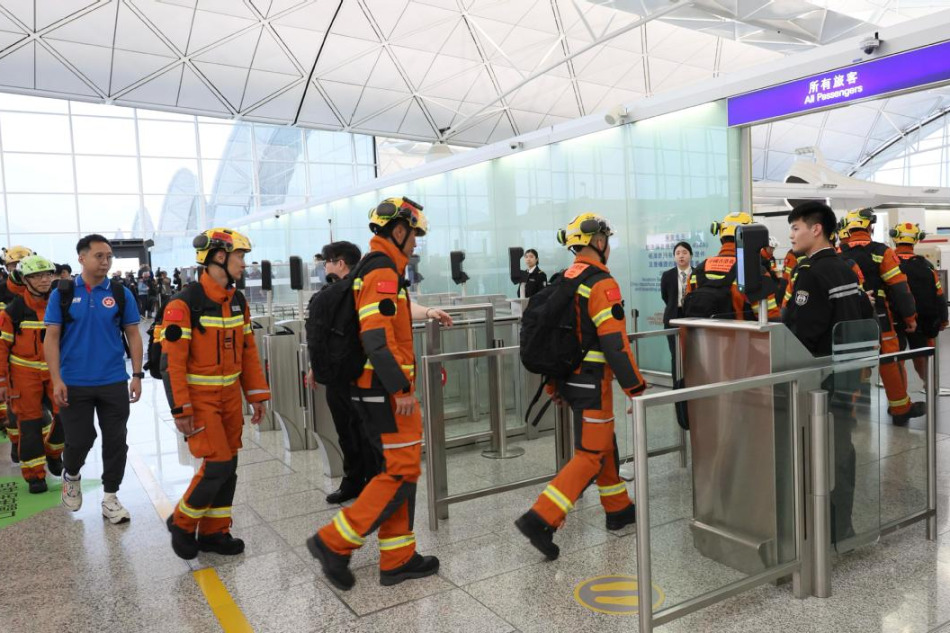HK under coronavirus: Giant lab for work-from-home

Working from home, Cherry Ko feels she's on call 24 hours a day and her work-life balance is coming apart.
It has been over a month since she last saw the inside of her office. Her company adopted a remote-working policy and then extended it, attempting to protect employees from the contagion of the novel coronavirus.
The 26-year-old finance assistant spent her holiday break on the mainland before she returned to Hong Kong and completed a two-week home quarantine. Ko has mixed feelings about working from home.
"It saves all the commute time, but creates barriers preventing me from retrieving data stored on servers and terminals," said Ko. "I am pleased with more flexible timetables, but also feel myself in a state of 24-hour standby."
As local infections of the deadly virus rose from the end of January, the city's biggest employer — the Hong Kong government — allowed its 176,600 civil servants to work from home until the beginning of March, except for those assigned to emergency and essential public services who continue to report for work as usual.
Kindergartens and primary and secondary schools will remain closed until mid-April. Most schools have shifted to holding classes online. Private employers were also urged to switch to flexible workplace practices to minimize the threat of the COVID-19 epidemic.
Iconic high-rise office buildings in the business heartland of Central remain mostly vacant. Hundreds of thousands of office workers in finance, insurance, law and other white-collar jobs now work from home. Hong Kong, with 88 percent of its working population in the service sector, has placed itself at the vanguard of the homeworking experiment.
Katryna Mojica, chief executive of Ogilvy Group HK, said this is "an extraordinarily challenging time that stretches organizations" because they have never worked from home for such a long period. Advertising and public relations companies usually require lots of in-person brainstorming activities to boost productivity.
"It can be difficult to work from home — you miss face-to-face connections, and there can be distractions or just a lack of space," said Mojica.
It's pretty much business as usual for her company, with flexible working rules and digital tools. She said, however, many of its more than 300 employees miss office life and the vibrancy of human interaction. "Being together supports collaboration and culture."
An upward trend
The number of homeworking people, excluding self-employed ones, surged 173 percent in the US between 2005 and 2018, according to Global Workplace Analytics, a research-based consulting firm. About 4.7 million US employees now work from home at least half the time, the firm said.
This trend shows no signs of slowing down around the globe, with multiple studies noting its desirable benefits, including reduced commute time, lower venue costs, increased productivity and higher job satisfaction.
The ongoing Hong Kong experiment, however, reveals there is a downside to working from home, especially when it becomes a necessity, rather than an option, to employers and employees who have little relevant experience or preparation.
Edmond Lai Shiao-bun, chief digital officer of the Hong Kong Productivity Council, said most of the city's small and medium-sized enterprises, due to lack of experience and resources, are finding it difficult to maintain quality operations.
SMEs also need strong technological support to ensure cybersecurity under telecommuting arrangements, said Lai, who, during the epidemic, has been advising companies on this "already-popular practice" in Western countries.
Meanwhile, about 10 employees, for whom telecommuting is a new practice, told China Daily they tend to be less productive when working at home due to a lack of discipline and distractions. They also reported communication with colleagues is less efficient.
A group of management trainees at Hang Seng Bank was found hiking in mid-February. They were supposed to be working from home when they posted photos on social media tagged "best work-from-home activity".
Tech as fuel
While company managers are turning to digital platforms in the hope of making remote working equally efficient, the scale of work-from-home caught even tech giants off guard during the epidemic.
Alibaba's teamwork app, Dingtalk, crashed because mounting video conference calls; Tencent's enterprise-tailored messaging app, WeChat Work, suffered unstable connections after its server became overloaded. Users of Baidu's office virtual private network were reportedly told to log out to allow managers to log in.
Silvina Moschini, president and founder of TransparentBusiness, a US-based remote working solution provider, said this epidemic underscored new tech's role in facilitating the work-from-home mode as a key element of emergency preparedness.
Her company offers enterprise software which provides functions that avoid inefficient "blind management" by keeping managers informed of the real-time status of their employees and their pending tasks.
She said Hong Kong's business leaders have to grasp this opportunity and use technology to build trustworthy workplace relationships where everyone feels valued, engaged and productive.
She sees it is an opportunity to expand her business on the Chinese mainland, as millions of workers are under travel restrictions. The same workers feel under pressure to get back to work, even while acknowledging those restrictions are meant to protect them from the coronavirus.
China's largest online job ad platform, 58.com, reported 55 percent of enterprises that delayed their work resumption had chosen telecommuting the epidemic. More than half of these enterprises are from digitally based industries such as information technology and telecommunications.
"Remote work is no longer a matter of convenience or financial savings; it has become a matter of containing a pandemic, a matter of life and death," she added.
In response to this crisis, TransparentBusiness donated $1 million worth of free software to China through the Chinese ambassador in the US to enable efficient remote working in the affected areas.
Blurred work-life boundaries
Telecommuting, meant for a better work-life balance, can also be stressful for some employees, as it blurs the boundary between office life and family life. It could be particularly annoying in places like Hong Kong with notoriously limited living space.
A European Union report in 2017 found "boundaryless work" can result in family conflict and stress, while remote workers are 16 percent more likely to endure high stress levels.
Jason, 32, works for a fintech company in Hong Kong that had already involved frequent telecommuting before the epidemic. He said his mental health has recently taken a hit after his workplace turned totally digital.
"The task-oriented, unplugging work mode has almost squeezed out the last inch of my personal space. Worse still is there are fewer outdoor activities to stretch myself out because of the coronavirus," he said.
As remote working is becoming the new normal for many, everyone needs to think about what makes them productive, happy and successful in everyday life, and try to replicate this in a remote setting, said Stephanie Russell, a business culture scholar at Anglia Ruskin University.
In a study conducted by the London School of Economics and Political Science in 2016, researchers found the lack of in-person interaction brings self-imposed pressure to work longer hours and reduces job satisfaction.
The study also indicated extensive use of homeworking, with its strong reliance on communication technology, increases the likelihood of isolation and frustration among workers.
Despite of existing downsides, video conferencing provider Owl Labs reported 42 percent of current remote workers plan to increase remote work in the next five years, with managers learning to deal with their emotional problems. Also, more than 50 percent of on-site workers want to work remotely.
- Young talent plays key role in shaping the future of innovation, experts say
- Internet media called on to swiftly adapt to digitalization trends
- Forum shares experience in poverty relief
- Algorithm discussion goes viral
- China unveils plan to turn permanent basic farmland into high-standard farmland
- Yunnan sends 7.3 tons of aid to Myanmar for earthquake relief





































